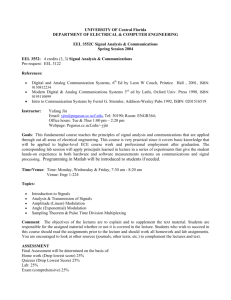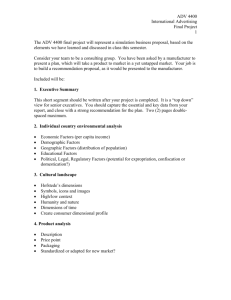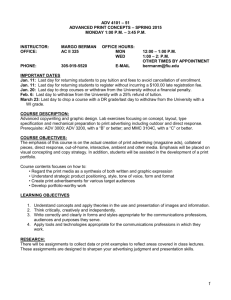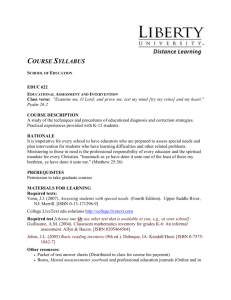ADV 4101 Gomez Fall14
advertisement
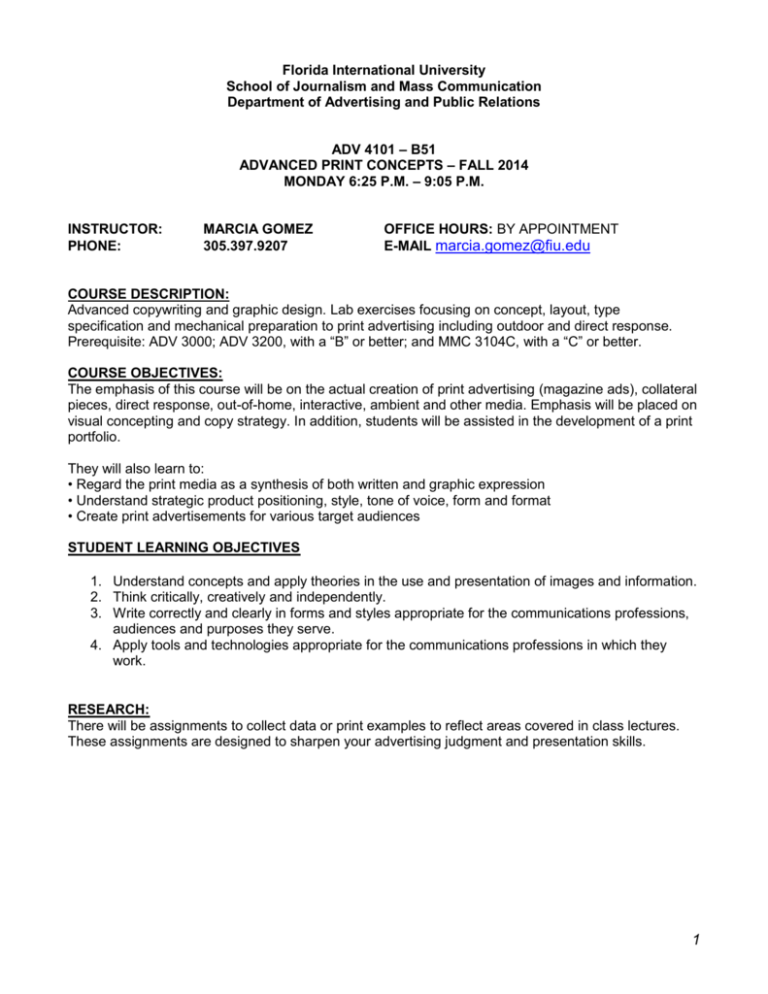
Florida International University School of Journalism and Mass Communication Department of Advertising and Public Relations ADV 4101 – B51 ADVANCED PRINT CONCEPTS – FALL 2014 MONDAY 6:25 P.M. – 9:05 P.M. INSTRUCTOR: PHONE: MARCIA GOMEZ 305.397.9207 OFFICE HOURS: BY APPOINTMENT E-MAIL marcia.gomez@fiu.edu COURSE DESCRIPTION: Advanced copywriting and graphic design. Lab exercises focusing on concept, layout, type specification and mechanical preparation to print advertising including outdoor and direct response. Prerequisite: ADV 3000; ADV 3200, with a “B” or better; and MMC 3104C, with a “C” or better. COURSE OBJECTIVES: The emphasis of this course will be on the actual creation of print advertising (magazine ads), collateral pieces, direct response, out-of-home, interactive, ambient and other media. Emphasis will be placed on visual concepting and copy strategy. In addition, students will be assisted in the development of a print portfolio. They will also learn to: • Regard the print media as a synthesis of both written and graphic expression • Understand strategic product positioning, style, tone of voice, form and format • Create print advertisements for various target audiences STUDENT LEARNING OBJECTIVES 1. Understand concepts and apply theories in the use and presentation of images and information. 2. Think critically, creatively and independently. 3. Write correctly and clearly in forms and styles appropriate for the communications professions, audiences and purposes they serve. 4. Apply tools and technologies appropriate for the communications professions in which they work. RESEARCH: There will be assignments to collect data or print examples to reflect areas covered in class lectures. These assignments are designed to sharpen your advertising judgment and presentation skills. 1 ADV 4101 – FALL 2014 – Page 2 of 9 REQUIRED TEXTS – THREE BOOKS: 1. Street-Smart Advertising: How to Win the Battle of the Buzz. Berman, Margo. Boulder: Rowman & Littlefield, 2010. ISBN 1-4422-0335-8 2. The Brains Behind Great Ad Campaigns: Creative Collaboration between Copywriters and Art Directors. Berman, Margo and Robyn Blakeman. Lanham: Rowman & Littlefield, 2009. ISBN 0-7425-5551-8 3. The Copywriter’s Toolkit: The Complete Guide to Strategic Advertising Copy. Berman, Margo. London: Wil Blackwell, 2012. ISBN 978-1-4051-9953-7 SUGGESTED READING: How to Market to People Not Like You: “Know It or Blow It” Rules for Reaching Diverse Customers. Kelly McDonald. Facebook Marketing: Leverage Social Media to Grow Your Business. Steven Holzner. Mobile Marketing: Finding Your Customers No Matter Where They Are. Cindy Krum. ProBlogger: Secrets for Blogging Your Way to a Six-Figure Income. 2nd ed., Darren Rowse and Chris Garrett. Strategic Uses of Alternative Media: Just the Essentials. Robyn Blakeman. The Tipping Point: How Little Things Can Make a Big Difference. Malcolm Gladwell. Blink. Malcolm Gladwell. Who Moved My Cheese? Spencer Johnson. The Bare Bones of Advertising Print Design. Robyn Blakeman, Rowman & Littlefield Publishers, 2005. ISBN 0–7425–2962–2. Graphic Design Solutions. Robin Landa. Delmar Publishers (Thomson), 1996. ISBN 0-8273-6352-4. Creating Brand Loyalty. Richard D. Czerniawski & Michael W. Maloney, Amacom. ISBN 0–8144–0501–0 Creating the Advertising Message. Jim Albright, Mayfield Publishing Co. ISBN 0–87484–884–9 The Copywriter’s Handbook. Robert W. Bly, Henry Holt & Co. ISBN 0–8050–1194–3 Guerrilla Marketing Attack. Jay Conrad Levinson, Houghton Miflin. ISBN 0–395–502209 22 Immutable Laws of Branding. Al Ries and Laura Ries, HarperBusiness. ISBN 0–88730-937-2 Write Great Ads. Erica Levy Klein, John Wiley & Sons. ISBN 0–471–50703–2 Confessions of an Advertising Man. David Ogilvy, Atheneum. ISBN 0–689–70601–4 Ogilvy on Advertising. David Ogilvy, Random House. ISBN 0–0–394–72903–X Marketing Warfare. Al Ries & Jack Traut, A Phone Book, ISBN 0–452–25861–8 Positioning. Al Ries & Jack Traut, ISBN 0–446–34794–9 Visual Literacy. Richard Wilde, Watson–Guptill Publications. ISBN–0–8230–5619–8 Mindmapping. Joyce Wycoff, Berkley Books. ISBN 0–425–12780–X GRAPHIC REFERENCES: (Award Show Annuals and Trade Publications) IMPORTANT DATES Aug. 24: Last day for returning students to pay tuition and fees to avoid cancellation of enrollment. Aug. 24: Last day for returning students to register without incurring a $100.00 late registration fee. Sept. 2: Last day to drop courses or withdraw from the University without a financial penalty. Sept. 19: Last day to withdraw from the University with a 25% refund of tuition. Nov. 3: Last day to drop a course with a DR grade/last day to withdraw from the University with a WI grade. 2 ADV 4101 – FALL 2014 – Page 3 of 9 COURSE REQUIREMENTS: Grades for this course are given on the following basis: 1. Homework assignments (equal weight: 3 @ 25% each) 75% a. Diesel Jeans creative brief, ad & mobile message (Jan. 27) b. Jaxson’s Ice Cream & Restaurant (Dania Beach) creative brief, ad, brochure, interactive idea (Feb. 24) c. Self-promotion (April 7) 2. Quizzes and/or class assignments (all equal weight) 25% 3. Research assignments – Quality of work may increase your final grade by one point. The professor reserves the right to adapt and/or change this syllabi as needed throughout the semester. ATTENDANCE: Attendance is REQUIRED. All students are excused from class on religious holidays. You are given one free late. After that, you will receive a one-point deduction off your final grade for every tardy and two points off your final grade for every unexcused absence. EXCUSED ABSENCES: Excused absences, which must be approved by the instructor, are only given in these three situations: 1. Personal or family health conditions, certified by a physician or counselor 2. Personal or family legal conditions, warranting your attention during class time and certified by an attorney or judge 3. University business, certified by a university official 4. Religious holidays GRADING: Grades for this course are determined as follows: A 92-100 C B- 80,81 D 62-66 A- 90,91 C+ 77-79 D+ 67-69 B+ 87,89 C 72-76 F 59-0 B 82-86 C- 70,71 Grades for assignments are as follows: 94 A, 90 A-, 88 B+, 84 B, 80 B-, 78 C+, 74 C, 70 C-, 68 D+, 64 D, 60 D- 59 and below F INCOMPLETES: Incompletes will be granted only under circumstances where a student experiences a major unanticipated event disruptive to his/her continuing in this course after having satisfactorily completed at least half the term. A student requesting an incomplete must present a written explanation detailing the circumstances that necessitate that request as well as an explanation as to how he/she will eventually complete the course requirements. Incompletes are not given to students as a way to avoid receiving a failing grade. 3 ADV 4101 – FALL 2014 – Page 4 of 9 COURSE STANDARDS: 1. MAKE–UP EXAMS/LATE PAPERS. There will be no make–up tests. All assignments are due at the beginning of class. Late assignments will receive a full letter grade deduction and must be turned no later than 1 week from the assigned date to receive any credit. There is no extension on the last assignment. 2. ASSIGNMENTS. Advertising is an image business. Although great ideas and concepts are critically important, presentation must not be overlooked. All copy must be typed in required format: double spaced, with one-inch margins on all sides. Papers should be edited for typos and spelling errors before they are submitted. Layouts must be free of visible corrections. DEPARTMENTAL WRITING POLICY: Good writing is vital in every career field. Accordingly, all students will be held to a uniform writing standard. All assignments, proposals and presentations will first be graded for content. Following that, the assignment will be reviewed for writing. Should an assignment contain six or more errors, the work will automatically lose 10 points (based on 100). At the instructor’s discretion, more stringent grading may be applied. This professor reserves the right to reduce your grade by one full letter grade on any assignment with 3 or more typographical errors. Assignments should be edited for typos and spelling errors before they are submitted. You will turn in a printed copy of the brand’s homepage for all assignments. If the brand’s name is misspelled, including hyphens, accent marks, or apostrophes, your grade will be lowered for that assignment. 3. CONTENT OF ASSIGNMENTS. All course work must be appropriate for the classroom and will be free of pornographic images or sexual explicitness. Student work may be shown to the class at any time. 4. LEVEL OF PERFORMANCE. At the end of the course, you will understand the role of the creative advertising person. You also will develop the skills needed to create and execute concepts. In addition, your creative judgment will be honed and fine–tuned. Plagiarism will cause a student to automatically fail the course and may lead to disciplinary action. You are required to be proficient InDesign, as well as Photoshop. If you are not functional in both of these programs, computer-training classes will be offered on Saturdays for a fee. The cost for each workshop is $15 (for AWC members), $20 (for members of any student organization) and $25 (for students who are not members of any group). You are required to attend these classes unless you can demonstrate proficiency in these programs if they are offered. SATURDAY AFTERNOON WORKSHOPS, 2 to 4 P.M. (AC II, 255 OR AC II, 242): Photoshop TBA InDesign TBA Dreamweaver (Web Design) TBA 5. FINAL PROJECT PRESENTATIONS. You are required to present your Final Project in person in class on the assigned day. You are required to sit through all other presentations. 4 ADV 4101 – FALL 2014 – Page 5 of 9 If you are late or leave early on the day of Final Project Presentations, you will automatically receive and “C-” (worth 70 points) or your completed Final Project. If you are absent, without an approved excuse, you will receive an "F" (worth 0 points). 6. HOMEWORK. Assignments are due at the beginning of class and cannot be printed out during class. 7. IN–CLASS CONDUCT. a. ALL PHONES MUST BE TURNED OFF. If the phone accidentally, the student will leave class, handle the call. b. STUDENTS ARE TO REMAIN OFF THE COMPUTERS UNLESS THEY ARE ON AN IN–CLASS ASSIGNMENT. Students will receive 1 point off your final grade if they are wandering on the Internet or doing non–assigned work while the professor is lecturing. c. ABOUT THE COMPUTER LAB: Students are expected to treat all hardware and software in the labs with care. You will be removed from the course, given a failing grade and face possible university disciplinary action and criminal prosecution if you: • Intentionally damage the equipment • Knowingly infect a computer with a virus • Destroy or tamper with the lab computer programming • Duplicate software in a lab The SJMC considers graphics software a tool, which is learned by repeated practice. The programs are available for student use in the SJMC Student Resource Center on the third floor. Academic Honesty In meeting one of the major objectives of higher education, which is to develop self-reliance, it is expected that students will be responsible for the completion of their own academic work. The use of literature, notes, aids, or assistance from other sources should be clearly identified with respect to all course assignments and examinations. In addition, students are expected to use all resources, including books, journals, and computers only in legal and authorized ways. They should also refrain from falsification of records, attend class as required, and participate in the educational process without disrupting the orderly processes and functions of the University. A great deal of time will be dedicated to idea generation, presentation and peer evaluation. This process is designed to develop your creative, presentation and judgment skills and help prepare you to function as a professional in the advertising arena. In class, you will experience the creative process with hands–on projects from a real–world perspective. Student with disabilities: If you have any special circumstances, please make me aware of them so that you may be better accommodated. For questions and information about support services, please call the FIU Office of Disability Services at 305-348-3532 (University Park Campus: GC 190) or 305919-5345 (Biscayne Bay Campus: WUC 139). Reading: 1) “Street” = Street-Smart Advertising, 2) “Brains” = The Brains Behind Great Ad Campaigns, and 3) “Copy” = The Copywriter’s Toolkit 5 ADV 4101 – FALL 2014 – Page 6 of 9 NOTE: BE SURE TO REVIEW "TERMINOLOGY" WORDS THROUGHOUT THE COURSE. Aug. 25 THINKING CREATIVELY. Various creative–stretching exercises. 1. Problem solving 2. What we’re trying to convey 3. The big connection – 2 things that don’t necessarily go together (CREATIVE VISUALIZATION TECHNIQUES) 4. Relaxation in creative process Read Street – Foreword, Intro, Ch. 1 and Toolkit – Ch. 1 ASSIGNMENT #1 FOR A GRADE - DIESEL JEANS = Work in teams of 2: art director and copywriter. DUE Sept. 8 Part One: Create a brief. Part Two: Develop the headline, tagline, visual and body copy and mobile message concept for Diesel Jeans ad. Include one additional creative idea that includes printed material in a different medium. Target audience: 18-24 plus. Tone of voice: flirty. Message: How to look and feel sexy – BE CREATIVE AND CLASS APPROPRIATE BASED ON 5 KEY POINTS: 1. Objective – What we’re trying to say 2. Target audience – Whom we’re talking to 3. Main consumer benefit – Why they should buy it 4. Why they should believe it 5. Tone of voice – Personality of product and ad Sept. 1 NO CLASS – LABOR DAY Sept. 8 THE BIG PICTURE – CONCEPT 1. Target 3. Tone of voice 5. Unique selling proposition 7. Point of view 2. Big idea 4. Approach (testimonial, hard sell, clever) 6. Marriage of visual and copy 8. Product positioning Read Street – Ch. 6, Brains – Ch. 1, Toolkit – Ch. 2 DIESEL JEANS ASSIGNMENT #1 DUE TODAY, SEPT. 8 Sept. 15 BASICS OF ADVERTISING. 1. The headline - main message 3. The offer (promotion) 5. The tagline (slogan) 7. The creative brief 2. The benefit (W–I–I–F–M) 4. The body copy (ABA format) 6. The call to action 8. The big idea that spins out Be persuasive. Concise. Create believability. Establish credibility. Read Street – Ch. 9, Brains – Ch. 2, Toolkit – Ch. 3 6 ADV 4101 – FALL 2014 – Page 7 of 9 Sept. 22 CAMPAIGN STRATEGY. Possible Speaker Discussion of advertising in the marketplace; analyzing what works, what doesn’t 1. Position product in market & in mind of consumer 2. Defining product 3. Identifying end–user 4. Determining product advantage (What makes it stand out – USP?) Read Street – Ch. 12, Brains –10, Toolkit – Ch. 13 and 14 Sept. 29 TYPOGRAPHY AND DESIGN: ADS AND BROCHURES. Possible Speaker 1. Use of design element 2. Composition & balance 3. Emphasis & order 4, Visuals: illustration, photography and graphics 5. Typography 6. Unity Read Street – Ch. 2 & 3, Brains – Ch. 6, Toolkit – Ch. 8 Oct. 6 AD CAMPAIGNS & BROCHURES. The integration of layout, design and copy. COPY: 1. Overall assembling of facts 2. Creation of headline & subheads 3. Organization 4. Connection to heads & subheads 5. Strong headline concept that spins out into campaign 6. Reread & reread aloud for: a. overall flow b. Typos c. unclear passages Street – Chs. 4 and 7, Brains – Ch. 4, Toolkit – Ch. 4 Assignment: #2 FOR A GRADE - PRODUCT: Jaxson’s Ice Cream & Restaurant (Dania Beach). Target families with children. DUE October 13 Work in teams of 2: art director and copywriter. Part One: Develop a creative brief. Part Two: Create headline, tagline, visual and body copy. Part Three: Design an interactive campaign idea. In one or two sentences only explain your idea. Part four: Create brochure layout that relates to ad and interactive idea. It should include: 1) cover, 2) headline 3) subheads and 4) visuals. Body copy is not required. SIZE: 8.5” x 11:” in a two-sided fold over or your choice of layout. Oct. 13 WRITING TECHNIQUES 1. Writing style 3. Simple sentences 5. Using ABA 7. Connectors 9. Alliteration 11. Parallel construction 2. Tying back to the headline 4. Clear, descriptive copy 6. Weaving 8. Contractions 10. Buttons 12. Vernacular Read Street – Ch. 5, Brains – Ch. 5, Toolkit – Ch. 9 JAXSON’S ICE CREAM PARLOR & RESTAURANT ASSIGNMENT #2 DUE TODAY, OCT. 13 7 ADV 4101 – FALL 2014 – Page 8 of 9 Oct. 20 CAMPAIGN TECHNIQUES. The basics. 1. Demonstrations – show product advantage (detergents) 2. Testimonials – for believability (weight loss programs) 3. Spokespeople – for awareness (Catherine Zeta-Jones – T-Mobile) 4. Slice of life – emotional sell (Hallmark) 5. Lifestyle – product in use – (mini vans) 6. Animation – for special communication (Little Caesar’s Pizza! Pizza!) 7. Humor – for entertainment 8. Sex – to sell sexy products (swim suits, tanning lotions) 9. Music – reinforcement of message 10. Eccentric casting/character – to stand out (Aflac duck, Geico gecko) 11. Unusual viewing techniques – to drive message home Read Street – Ch. 8, Brains – Ch. 7, Toolkit – Ch. 10 Oct 27 POSSIBLE GUEST SPEAKER DISCUSS FINAL PROJECT: A SELF–PROMOTION CAMPAIGN Nov. 3 ON-STRATEGY, ON-TARGET CREATIVE CAMPAIGNS Read Street – Ch. 10, Brains – Ch. 8, Toolkit – Ch. 11 Nov. 10 MEET WITH PROFESSOR ONE-ON-ONE IN CLASS TO DISCUSS SELF-PROMOTIONS Read Street – Ch. 11, Brains – Ch. 9, Toolkit – Ch. 12 Nov. 17 POSSIBLE GUEST SPEAKER Q&A ON FINAL PROJECT (SELF-PROMOTION CAMPAIGN) NOV. 24 SELF-PROMOTION PRESENTATIONS REMINDER NOTE: FINAL PROJECT PRESENTATION ON NOV. 24 REMINDER: 1) BRING 2 COPIES OF YOUR SELF PROMOTION CAMPAIGN. 2) WEAR BUSINESS ATTIRE 3) Write critique of other presentations. 4) Bring project in on a CD-ROM / FLASH DRIVE Save as a TIFF, EPS, or JPEG file at 300 dpi. 5) Bring copy on paper for professor. (It can be a photograph of project.) Dec. 1 DISCUSSION AND CRITIQUES OF FINAL ASSIGNMENT Dec. 8 NO FINAL EXAM - MEET WITH PROFESSOR ONE-ON-ONE 8 ADV 4101 – FALL 2014 – Page 9 of 9 ASSIGNMENT GRADING POLICY- ADV 4101 All graded assignments will be judged on the following criteria. (#1, 4 and #5 =13 points each, #2-3 and #6 =11 points each, #7 = 28 points 1. Concept - message relevance and continuity (one big idea that spins out) a. Point of view - choice of voice b. Overall strength of message c. Memorability 2. Audience(s) - clear definition, appropriateness, feasibility and justification 3. Benefits - identification, clarification and responsiveness to audience needs Reason why - accuracy, relevance and value to audience 4. Copywriting - clarity of message, a. Flow b. Weave of concept c. ABA d. Alliteration, parallel construction, connectors b. Tone of voice - appropriate for brand and audience e. Headline 5. Layout - effectiveness in communicating message a. Use of typography - strong choice of fonts, sizes and placement b. Use of visuals - attention getting and appropriateness c. Use of space - balance and composition 6. Positioning - uniqueness, distinctive impression and recognition in consumer’s mind Memorable tagline 7. Creativity - demonstration of imaginative, original thought and feasibility of ideas in choice of: a. audience b. alternative media c. overall strategy 9
